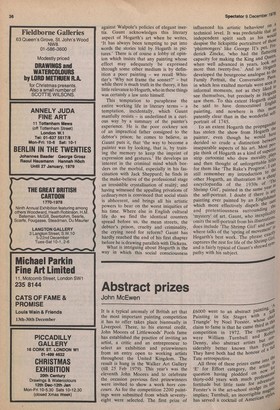Abstract prizes
John McEwen
It is a typical anomaly of British art that the most important painting competition it has to offer takes place biannually in Liverpool. There, to his eternal credit, John Moores of Littlewoods' Pools fame has established the practice of inviting an artist, a critic and an entrepreneur to select an exhibition and prizewinners from an entry open to working artists throughout the United Kingdom. The result is hung in the Walker Art Gallery (till 25 Feb 1979). This year's was the eleventh John Moores and to celebrate the occasion previous first prizewinners were invited to show a work hors concours. As for the competition 2200 paintings were submitted from which seventyeight were selected. The first prize of £6000 went to an abstract pail16fli'5:; Painting in Six Stages with a hie( Triangle' by Noel Forster, whose ctto claim to fame is that he came third infs',0 competition in 1972. The rtmily0 were William Turnbull and Denny, also abstract artists but siderably better known than Ft°1?-011 They have both had the honour 01 " Tate retrospective. All three of these prizes came int° tilica `E' for Effort category, the artif fof question having plodded 00 thirty-odd years with much profe"',-to. fortitude but little taste for advell`titie Forster's is the art-school stodge its,roje, implies; Turnbull, an incorrigible ina,n,, has served a cocktail of American one part Tobey to four of Ryman, whose white-on-white appearance has stirred a few old philistines to life despite its seasonal appeal; and dandy Denny, more internally decorative than ever, has a geometric painting that looks like the floor-plan for a suit in honour of Josef Albers. This art school desire to be seen to be professional, to be seen to be know lug about art in the same way that musical audiences titter at musical jokes to Show that they know about music, pervades much of this year's show. And yet there were some good paintings by some of our best artists that went quite unre warded i , a Hodgkin and a Caulfield n Particular. Lesser prizes might well have gone to some assured abstract works by the Younger generation of Michael Bennett, Jiro Latter and Hugh O'Donnell. And Michael Craig-Martin and Knighton posking were also unlucky to be overlooked. Of those rewarded Martin Naylor, Peter Joseph and Karl Martin Wesejlice were the most deserving. Lonnie Empire. The onegan was playing The onegan was playing The John Moores too tends to go to pro vmcial top-of-the-billers. This year's losers Will have to comfort themselves with that and pray for a friend on the jury next time round. Latest to run the gauntlet of a retrospective is Barry 7.January 1979). Flanagan (Serpentine till Flanagan is a charmer; who else would conclude an introductory note by wishing his art colleagues well, but charm, as we all know, is a will o' the wispish quality and not to be pondered on. His show accordingly flatters to deceive, delightful on a first visit it wears distinctly thin in parts on a second. Flanagan first came to attention with works that incorporated sand, sacking and rope. These materials he deployed with wit and as much physical pleasure as a boy let loose in a sand-pit. He bagged sand into shapes as comically squat as puddings or into tapering columns that artfully combined both stout weight and delicate contours, He piled hessian sacks and painted them with a rectangular light-beam. He drew with rope. Such pieces are on view in the current show and they stand the test of a decade's lapse of time very well, their stylistic sophistication nicely counter-balanced by the simplicity of their method. But Flanagan then chose to move away from his delight in volume, the simple side of things, to pursue style. He did a series of increasingly twee works in canvas which amount to little more than whimsical asides on the state of painting. Thankfully in recent years a return to stone has once more engaged his least disingenuous and most intuitive self, but whimsy is creeping back here again and in the final pieces volume is once more abandoned for linear paper-games in metal. Things are not improved by the selection which con centrates on this whimsy at the expense of sensuality. It gives an unfair impression: there is no substantial intermediary stone-piece and not one of his recent and beautiful pinch-pots to be seen. One can only hope that volume will prevail in the end.
Martin Naylor's latest show 'A View Beyond the City' (Rowan till 14 December) is, as the incorporate title conveys, consciously transitional. It is better than his previous show more concentrated and explicit without losing any of the emphatic edge. Naylor is a fullblooded romantic artist and therefore tends to express very personal themes. He does not see art as a classical quest for simplicity. For him it is about feelings, their reality and complexity. If he cannot convey this in one medium then he will resort to a gamut of them. This is the advantage of the visual artist, and Naylor has never exploited it more fully than in the current show. Many of the pieces incorporate written analyses like fragments from a subjective novel, photographs, drawing, painting and a sculptural element on the floor underneath. All deal with the conflict of the sexes. The most transitional, and therefore least happy element, appears to be the writing. The best pieces speak more subtly without it. But Naylor on this form remains one of the most invigoratingly reckless artists around, and blessed, as Nietzsche said, with taste.















































 Previous page
Previous page